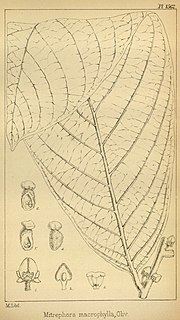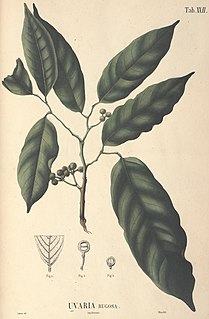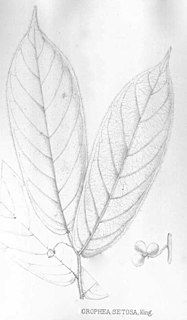Pseuduvaria bruneiensis is a species of plant in the family Annonaceae. It is endemic to Borneo. Yvonne Chuan Fang Su and Richard M.K. Saunders, the botanists who first formally described the species, named it after Brunei where the specimens they examined were collected.
Pseuduvaria clemensiae is a species of plant in the family Annonaceae. It is native to New Guinea. Yvonne Chuan Fang Su and Richard M.K. Saunders, the botanists who first formally described the species, named it after Mary Strong Clemens who collected the specimen they examined.
Pseuduvaria coriacea is a species of plant in the family Annonaceae. It is native to New Guinea. Yvonne Chuan Fang Su and Richard M.K. Saunders, the botanists who first formally described the species, named it after its leathery leaves.
Pseuduvaria costata is a species of plant in the family Annonaceae. It is native to New Guinea. Rudolph Scheffer, the Dutch botanist who first formally described the species using the basionym Orophea costata, named it after its prominently ribbed fruit.
Pseuduvaria cymosa is a species of plant in the family Annonaceae. It is native to Peninsular Malaysia. James Sinclair, the Scottish botanist who first formally described the species using the synonym Pseuduvaria macrophylla var. cymosa, named it after its branched inflorescences which are called cymes.
Pseuduvaria hylandii is a species of plant in the family Annonaceae. It is native to Australia. L.W. Jessup, the botanists who first formally described the species, named it after Bernard Hyland an Australian botanist who collected the specimen he examined.
Pseuduvaria kingiana is a species of plant in the family Annonaceae. It is native to the Malay Peninsula. Yvonne Chuan Fang Su and Richard Saunders, the botanists who first formally described the species, named it after Sir George King, the British botanist who first collected the species.
Pseuduvaria lignocarpa is a species of plant in the family Annonaceae. It is native to New Guinea. James Sinclair, the Scottish botanist who first formally described the species, named it after the woody wall of its fruit.
Pseuduvaria luzonensis is a species of plant in the family Annonaceae. It is native to The Philippines. Elmer Drew Merrill, the American botanist who first formally described the species using the synonym Orophea luzoniensis, named it after Luzon in the Province of Battan, Philippines where the specimen he examined was collected along the Lamao River.

Pseuduvaria macrophylla is a species of plant in the family Annonaceae. It is native to Peninsular Malaysia, Sumatra and Thailand. Daniel Oliver, the English botanists who first formally described the species using the synonym Mitrephora macrophylla, named it after its large leaves.
Pseuduvaria mindorensis is a species of plant in the family Annonaceae. It is native to the Philippines. Yvonne Su and Richard Saunders, the botanists who first formally described the species, named it after the island of Mindoro where the specimen they examined was collected in the municipality of Puerto Galera.
Pseuduvaria mollis is a species of plant in the family Annonaceae. It is native to New Guinea. Otto Warburg, the German-Jewish botanists who first formally described the species using the basionym Goniothalamus mollis, named it after the soft hairs on its leaves and petals.
Pseuduvaria guineensis is a species of plant in the family Annonaceae. It is native to New Guinea. James Sinclair, the Scottish botanist who first formally described the species, named it after New Guinea where the specimen he examined was collected near Kokoda.
Pseuduvaria obliqua is a species of plant in the family Annonaceae. It is native to Borneo. Yvonne Su and Richard Saunders, the botanists who first formally described the species, named it after its slightly uneven leaf bases.
Pseuduvaria pamattonis is a species of plant in the family Annonaceae. It is native to Borneo and the Philippines. Friedrich Miquel, the Dutch botanist who first formally described the species using the basionym Orophea pamattonis, named it after a mountain in Borneo called Gunung Pamaton.
Pseuduvaria parvipetala is a species of plant in the family Annonaceae. It is native to Borneo and Sumatra. Yvonne Su and Richard Saunders, the botanists who first formally described the species, named it after its small petals.
Pseuduvaria philippinensis is a species of plant in the family Annonaceae. It is native to the Philippines. Elmer Drew Merrill, the botanist who first formally described the species, named it after the Philippines where the specimen he examined was collected in the Province of Quezon.

Pseuduvaria reticulata is a species of plant in the family Annonaceae. It is native to Bangladesh, Borneo, Java, the Lesser Sunda Islands, Myanmar and Sumatra. Carl Ludwig Blume, the botanist who first formally described the species under the basionym Uvaria reticulata, named it after the net-like pattern of veins on the underside of its leaves.

Pseuduvaria rugosa is a species of plant in the family Annonaceae. It is native to Java, Laos, the Lesser Sunda Islands, Peninsular Malaysia, Myanmar, the Nicobar Islands, Sumatra and Thailand. Carl Ludwig Blume, the botanist who first formally described the species under the basionym Uvaria rugosa, named it after its wrinkled fruit.

Pseuduvaria setosa is a species of plant in the family Annonaceae. It is native to Peninsular Malaysia. George King, the botanist who first formally described the species under the basionym Orophea setosa, named it after the bristly hairs on its leaves and petioles.



